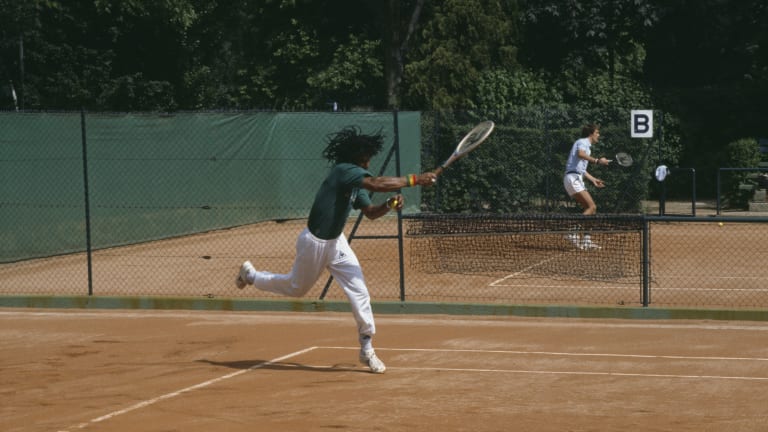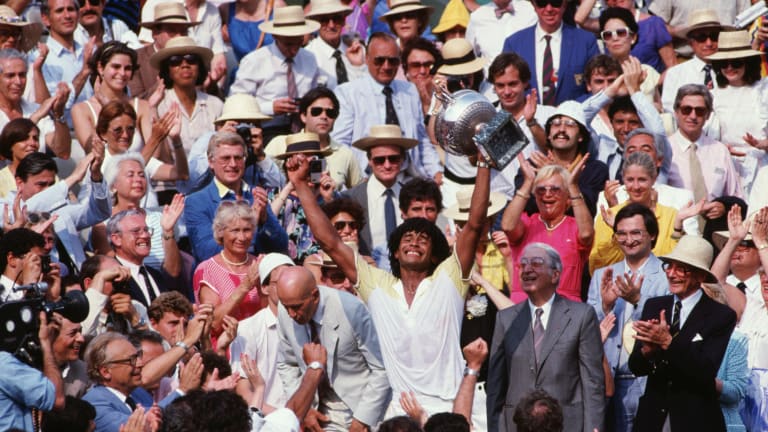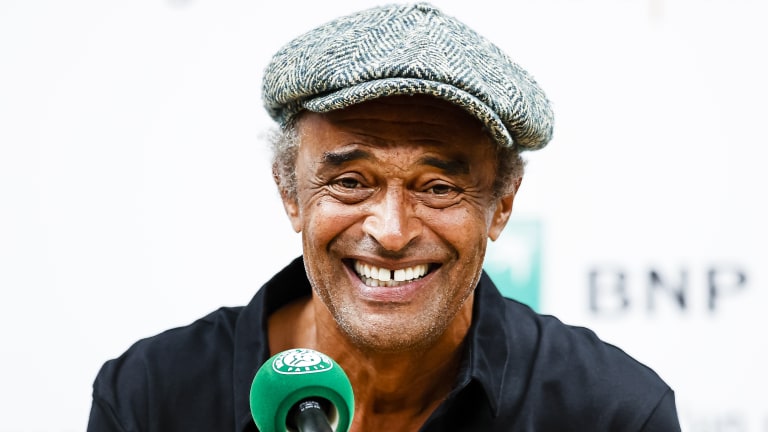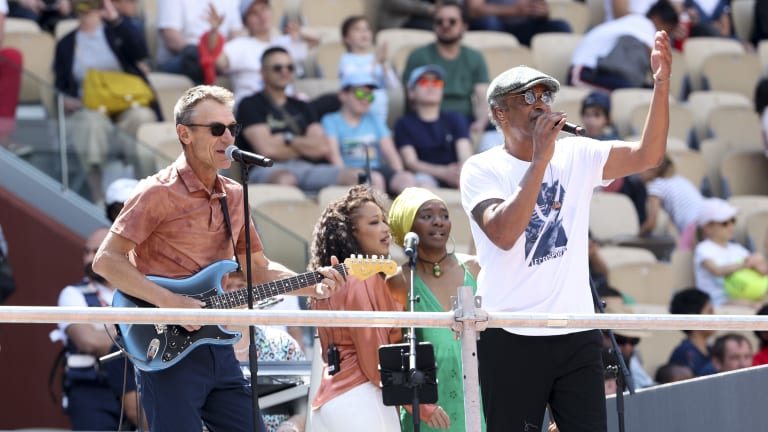One-Slam Wonderful: Yannick Noah's Roland Garros title, 40 years later
By Peter Bodo Jun 11, 2023The mindset of a super squad: How Danielle Collins, Emma Navarro and Tommy Paul became U.S. tennis stars
By TENNIS.com Oct 30, 2025The mindset of a disruptor: Daniil Medvedev and Jelena Ostapenko harness the chaos
By Stephanie Livaudais Oct 29, 2025The mindset of a finalist: Sinner, Pegula and Zverev on what gives them a mental edge
By Ed McGrogan Oct 28, 2025Fifty years after winning her first US Open, Chris Evert says her legacy won’t be contained in a trophy case
By Chris Evert Sep 05, 2025Welcome to Tennis Channel Airlines ✈️
By Ed McGrogan Jul 15, 2025Henry Searle, 2023 Wimbledon boys' champ, trusts self-improvement mindset will see things fall into place
By TENNIS.com Jun 29, 2025On the first day of the Paralymics in Paris, an ode to wheelchair tennis
By Laya Albert Aug 28, 2024What “gift” each American men's contender needs to get over the Grand Slam hump
By Peter Bodo Mar 03, 2024"That Red Light" & The Blueprint: Returning to Lowell, where 20 years ago today, Tennis Channel went live for the first time
By Ed McGrogan Apr 26, 2023One-Slam Wonderful: Yannick Noah's Roland Garros title, 40 years later
The Frenchman never won another Grand Slam title, but that fact doesn't make his crowning achievement in Paris any less memorable.
Published Jun 11, 2023
Advertising
Unstrung: Jon Wertheim on Yannick Noah's 1983 title run at Roland Garros
It was the mid-1980s, and New York City was awash in clubs like the Purple Barge, one of the many venues that popped up like mushrooms after rain, chasing the post-punk vibe. It was, indeed, a barge, moored on the Hudson River in downtown Manhattan. I was posted up along the bar in the wee hours one morning when I heard my name called and, turning, saw Yannick Noah.
Approaching, Noah said, apropos of nothing, “Man, you look old.”
I might have taken offense, but the French tennis star’s broad smile, all the more disarming for the gap in his front teeth, precluded taking offense. We chatted a bit, then he went off to rejoin his friends, leaving me to contemplate our emblematic interaction. Truth is, Noah could have told ’80s film star Jessica Lange that she “looked old” and probably gotten away with it. He was that charismatic. His smile and voice were that winsome. And he was that candid—and, frankly, that bold.
Forty years ago, those qualities, combined with big-cat athleticism and a swashbuckling style, helped Noah become the first Frenchman to win the Roland Garros singles title in 37 years. It was a triumph with many layers of meaning, not least for those off of tennis’s overwhelmingly Caucasian spectrum. No Black man had claimed a Grand Slam singles title since Arthur Ashe won Wimbledon in 1975.
Advertising
The whole world changed around me, and it was so fast and so strong. I got really scared. Yannick Noah
The barge was no celebrity hangout (there was no doorman or price of admission, and the only ropes out front were of hemp, not velvet). Nobody made a fuss over Noah, I’m not sure anyone even recognized him. He was easily taken for an NYU grad student, perhaps a model or actor. And that was just fine by Noah.
Although a stare by nature as well as accomplishment, Noah wanted to live with elbow room, which is how he came to be on the Purple Barge that night, after fleeing Paris soon after his shocking win at Roland Garros seduced all of France, and much beyond. A free spirit, he felt so entombed by celebrity that before the year of his great coup was out, he found himself standing on bridge in Paris, peering down into the dark waters of the Seine, contemplating suicide.
“The fact of winning was like a shock for me.” Noah told the New York Times many years later. “The whole world changed around me, and it was so fast and so strong. I got really scared. . . If you can learn from it, it's a wonderful lesson. If not, it can be devastating.”
Noah learned.
Advertising

Yannick Noah practicing alongside fellow Frenchman Christophe Roger-Vasselin, before their unexpected semifinal encounter.
© Arnaud De Wildenberg
Mats Wilander did not realize how much trouble he had bought until about 30 minutes into that 1983 Roland Garros final. He knew going in that the long-suffering French fans would be behind Noah en masse. It was evident in the warm-up, when they greeted every stroke of Noah’s with a rousing “Oui,” while every Wilander swing was met with stone-cold silence.
Although he was still just 18, the defending champion was unflappable. Going into the match, Wilander knew that Noah had sidestepped a seemingly insurmountable obstacle when his compatriot Christophe Roger-Vasselin—ranked No. 139—reached the semifinals via an upset of top-seeded Jimmy Connors. Noah then demolished Roger-Vasselin 6-3, 6-0, 6-0, but Wilander wasn’t overly concerned. He told me in a recent interview, “I was thinking, ‘There’s no way I can lose to Noah in a five-set match.’”
Noah, the son of a Black Cameroonian pro soccer player and white mother, had been discovered at age 11 by Ashe while the American star was on a government-sponsored goodwill tour. Ashe successfully lobbied the FFT (French Federation of Tennis) to bring Noah to Paris for training. The FFT specialized in allowing the natural flair and creativity of players to blossom, hence the nation’s continuing stream of interesting, creative stylists with groundstrokes developed for success on Roland Garros’ terre battue. But Noah was not one of them. His athleticism was of another order of magnitude.
“He didn’t have that French flair with his groundstrokes, like an Henri LeConte or Guy Forget,” ESPN analyst Brad Gilbert, who had a 2-1 career record against Noah, told me. “He was really more like a throwback to the 1970s. Huge serve. He liked to chip-and-charge behind his slice backhand, or serve-and-volley. His slice serve was amazing. He was this laid-back dude and just from his presence you wouldn’t think he would play the way he did.”
Advertising
I had never experienced a tennis player that was so in your face as him that day. Maybe Connors, but Yannick was different. It was more like Rafa (Nadal), and just like Rafa, Yannick was aggressive in a very humble, very sporting way. Mats Wilander
Wilander was well into the first set by the time he realized that he had been lulled by his apparent advantage on clay. While an expert problem solver, he was not accustomed to problems Noah presented.
“It was like, ‘Okay, he’s coming to the net. Now he hits a drop shot. Now a heavy slice. Now he hits a high forehand and now he serves and volleys.’ Yannick never allowed me to get in a groove and solve one problem at a time,” Wilander told me. “That was a very uncomfortable feeling, and for me it was a new feeling. It never happened to me on clay before.”
Plenty of players had rolled the dice and tried to overwhelm masters of defense on clay, almost always discovering that aggressive tactics were difficult to maintain over the course of long matches on red clay. But Noah proved relentless.
“I had never experienced a tennis player that was so in your face as him that day,” Wilander said. “Maybe Connors, but Yannick was different. It was more like Rafa (Nadal), and just like Rafa, Yannick was aggressive in a very humble, very sporting way.”
Advertising
Five days in, no players left. Why do the French struggle so much at Roland Garros? 🇫🇷
— TENNIS (@Tennis) June 2, 2023
In the latest edition of #TalkingTenniswithTracy, Hall of Famer @TheTracyAustin Austin offers a deeper look at the host nation’s clay-court conundrum. ⬇️ pic.twitter.com/Y7XwuffGfh
More often than not, French players have struggled with the pressure that builds up at Roland Garros. The crowd is very supportive, but underneath that affection lies a bedrock of expectations. Wilander believes that French players often look to the crowd, “begging” them to believe—while forgetting that they need to do their part, too. They need to sell it, demonstrating passion and confidence.
Noah, all exuberance, flying dreadlocks, daring volleys, was more than willing and able to do that.
“Yannick had that confidence that others never did,” Wilander said. “He told the crowd, ‘Hey, I’m here, I’m not going anywhere. I have a solution to this guy Mats Wilander, and you should come with me because it's going to be a great ride.”
Noah was in full command of the match, and he both carried and was transported by the ebullient crowd. It got to the point where, by the closing games of the third and final set, as the men approached what proved to be the decisive tiebreaker in Noah’s three-set win, Wilander felt like he was “a spectator of something I had never experienced before.”
Advertising

Noah was in full command of the 1983 final, and he both carried and was transported by the ebullient crowd.
© Corbis/VCG via Getty Images
No French player alive today has known anything like that extended moment of glory visited upon Noah in 1983. Yet Noah never did win another major. In fact, he reached just one Grand Slam semifinal in the years after he won at Roland Garros.
Tim Wilkison, a solid American pro who won three of his seven matches with Noah, thinks that may have been because Noah’s game contained weaknesses that were as conspicuous as his strengths—starting with a backhand Noah only hit with slice.
“I felt I could hang in there with him because he had some holes in his game,” Wilkison told me. “That isn’t really a criticism. It just makes what he did achieve that much better.”
It is hard to imagine how Noah could have squeezed much more Grand Slam gratification out of his game as well as his crowded, multi-faceted life. Fleeing Paris at the beginning of 1984, he basked in the relative anonymity of New York City. He started a family and exercised his free spirit while maintaining his career, achieving success on both fronts. Noah won 23 singles titles, was ranked as high as No. 3 in the world (and No. 1 in doubles), and he finished the ATP year in the Top 10 four times. Barely a year after he officially retired in 1990, Noah—a man of second, third and fourth acts—accepted the Davis Cup captaincy and ended the nation’s Davis Cup drought of 59 years. The squad upset an American unit featuring rookie Pete Sampras.
A career in tennis did not stop Noah from fronting a fashionable Soho restaurant (LeGuignol), where the wine flowed freely for his friends and guests. Noah smoked cigarettes (among other things); he fathered five children (including former NBA all-pro Joakim Noah), wed three wives, and enjoyed a remarkable second career as a musician. His song “Saga Africa” hit No. 2 in France and charted high in Europe as well, in the same year he masterminded France’s brilliant Davis Cup win. Noah is the only former ATP pro who has a channel on Spotify, and his Wikipedia page boasts of a discography as rich as his statistical record in tennis. Noah once sang at the Stade de France, before 80,000 people.
Advertising
He wasn’t just being a good sport—he was being a sincere human being, which I think is actually what he is. Tim Wilkison
Now 63, Noah’s popularity with the public was matched only by the esteem in which he was held by his peers. Wilkison was ranked No. 31 when he upset Noah in the third-round of the 1986 US Open.
“It was a super intense match, five sets,” Wilkison told me. “It was a bad loss for him, but after the match he gave me a very sincere hug, a smile, and congratulations. It was a rare thing to do back then, when players were much less empathetic. He wasn’t just being a good sport—he was being a sincere human being, which I think is actually what he is.”
Stories abound of Noah’s largesse and amiability toward his fellow pros. At the peak of his fame, Noah invited Gilbert to play three exhibitions with him in France. Gilbert found himself moved by how much Noah cared about “putting on a show,” irrespective of who would win the matches.
Even though they were as different as chalk and cheese, Noah was not going to let Gilbert sit around in a hotel room during down time. He welcomed Gilbert to his home. He even did his best to introduce straight-arrow Gilbert to France’s racy nightlife.
“We went out somewhere but, man, I didn’t have his kind of stamina,” Gilbert told me. “I would say I was a D-minus in that area. I was like, ‘Oh my gosh, it’s too loud, it’s too crowded.’ You couldn’t reach out your hand in that place without touching somebody. I was like, ‘Nah, not for me.’ But Yannick made that effort.”
Advertising

No one may personify joie de vivre quite like Yannick Noah.
© Getty Images
Noah may have won just one major, but he left a large footprint in the game. In Wilander’s view, Noah successfully transformed a culture that was somewhat sour and inward looking—one in which nobody cared about being popular, or about his peers, just about being great.
“Mac (John McEnroe) couldn’t care less. Neither did Connors, nor (Bjorn) Borg.” Wilander said. “Yannick didn’t really clown around, but he showed that being popular could be fun. People really responded to that. He opened the door for the Andre Agassi phenomenon, which had more to do with Yannick than with Connors or Mac.”
Wilander had his own eyes opened by Noah’s cosmopolitan attitude. He said that, were it not for Noah’s relaxed attitude toward his career, he might not have risked moving from Sweden to New York to live with his girlfriend (now his wife).
“Yannick was the first person I knew who was really worldly,” Wilander said. “He opened my eyes to not be so Swedish, to broaden my horizon. I started to allow myself to be the person I am inside of myself, not outside, the way I was as a tennis player. I learned that it’s only about tennis on the court. Everywhere else, it’s about life.”
Advertising

Noah and Wilander, enjoying a different craft at Stade Roland Garros, 40 years after their final-round collision.
© Getty Images
Noah was at his peak just before the onset of the push for diversity in tennis. He certainly had racial awareness but, influenced by his multi-racial background, the assimilationist philosophy of France, and his own worldliness, he wasn’t overly concerned with identity or tennis’ lack of diversity. He had an interesting relationship with Ashe, but a sense of indebtedness is never a good binding agent.
Wilkison never thought much about the race-based legacy of Noah, but when Wilkison signed up as the coach of a promising African-American junior from Savannah, Ga., the 17-year old kid showed up one day in a t-shirt that said, “Arthur Ashe. . .Yannick Noah. . .Who’s Next?”
Whoever that is will have, as Noah did, a very hard act to follow. Those who count titles and live deep within the tennis bubble may be tempted to write Noah off as a One-Slam Wonder. But out in the larger world where Noah preferred to live, he’s One-Slam Wonderful.